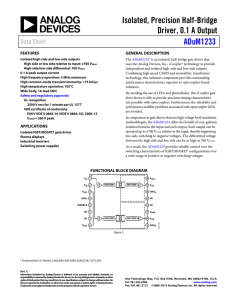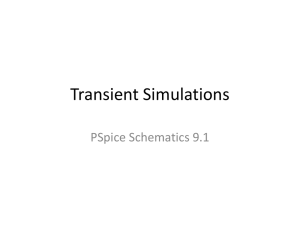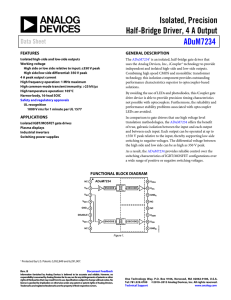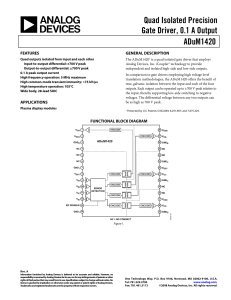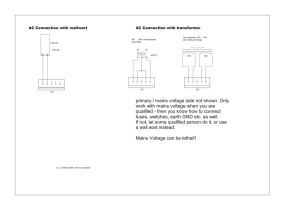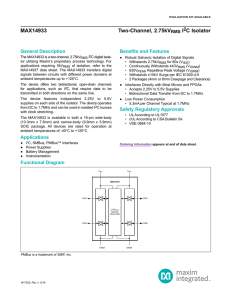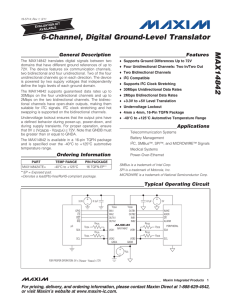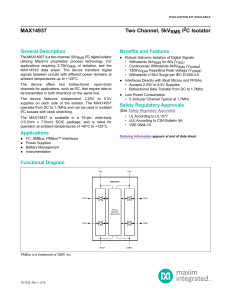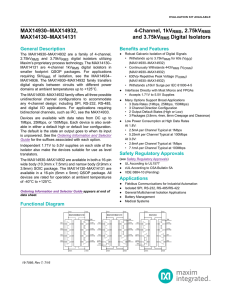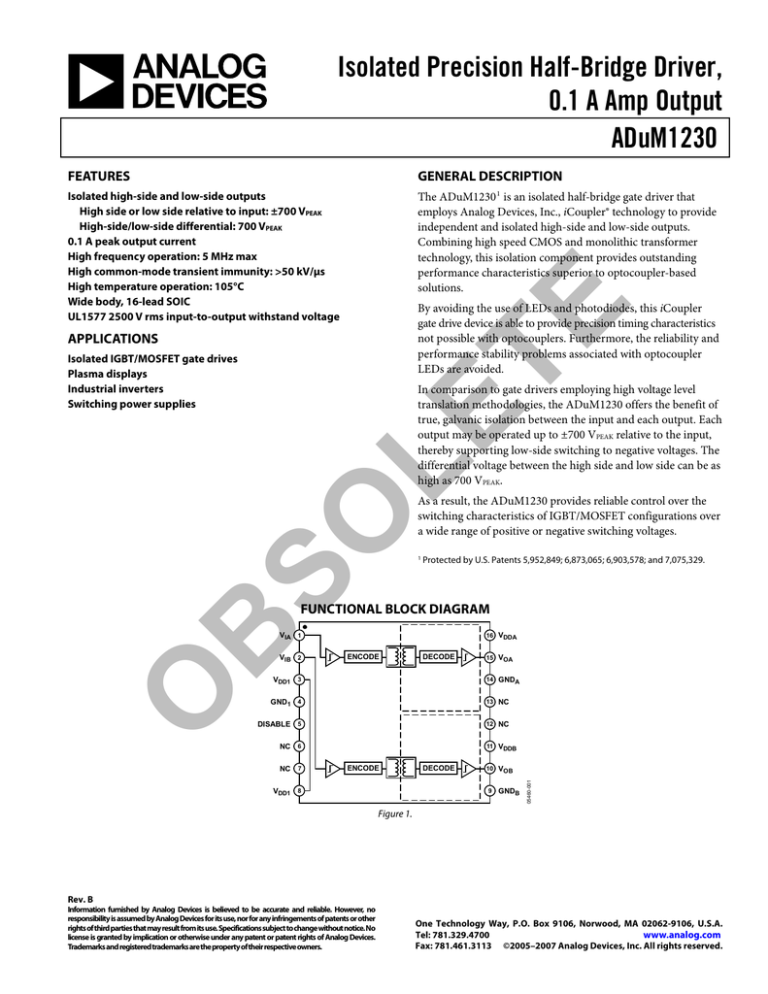
Isolated Precision Half-Bridge Driver,
0.1 A Amp Output
ADuM1230
GENERAL DESCRIPTION
Isolated high-side and low-side outputs
High side or low side relative to input: ±700 VPEAK
High-side/low-side differential: 700 VPEAK
0.1 A peak output current
High frequency operation: 5 MHz max
High common-mode transient immunity: >50 kV/μs
High temperature operation: 105°C
Wide body, 16-lead SOIC
UL1577 2500 V rms input-to-output withstand voltage
The ADuM1230 1 is an isolated half-bridge gate driver that
employs Analog Devices, Inc., iCoupler® technology to provide
independent and isolated high-side and low-side outputs.
Combining high speed CMOS and monolithic transformer
technology, this isolation component provides outstanding
performance characteristics superior to optocoupler-based
solutions.
TE
FEATURES
By avoiding the use of LEDs and photodiodes, this iCoupler
gate drive device is able to provide precision timing characteristics
not possible with optocouplers. Furthermore, the reliability and
performance stability problems associated with optocoupler
LEDs are avoided.
APPLICATIONS
Isolated IGBT/MOSFET gate drives
Plasma displays
Industrial inverters
Switching power supplies
B
SO
LE
In comparison to gate drivers employing high voltage level
translation methodologies, the ADuM1230 offers the benefit of
true, galvanic isolation between the input and each output. Each
output may be operated up to ±700 VPEAK relative to the input,
thereby supporting low-side switching to negative voltages. The
differential voltage between the high side and low side can be as
high as 700 VPEAK.
As a result, the ADuM1230 provides reliable control over the
switching characteristics of IGBT/MOSFET configurations over
a wide range of positive or negative switching voltages.
1
Protected by U.S. Patents 5,952,849; 6,873,065; 6,903,578; and 7,075,329.
FUNCTIONAL BLOCK DIAGRAM
VIA 1
ENCODE
DECODE
VDD1 3
15 VOA
14 GNDA
GND1 4
13 NC
DISABLE 5
12 NC
NC 6
NC 7
11 VDDB
ENCODE
VDD1 8
DECODE
10 VOB
9
GNDB
05460-001
O
VIB 2
16 VDDA
Figure 1.
Rev. B
Information furnished by Analog Devices is believed to be accurate and reliable. However, no
responsibility is assumed by Analog Devices for its use, nor for any infringements of patents or other
rights of third parties that may result from its use. Specifications subject to change without notice. No
license is granted by implication or otherwise under any patent or patent rights of Analog Devices.
Trademarks and registered trademarks are the property of their respective owners.
One Technology Way, P.O. Box 9106, Norwood, MA 02062-9106, U.S.A.
Tel: 781.329.4700
www.analog.com
Fax: 781.461.3113 ©2005–2007 Analog Devices, Inc. All rights reserved.
ADUM1230* Product Page Quick Links
Last Content Update: 08/25/2016
Comparable Parts
Reference Materials
View a parametric search of comparable parts
Press
• Analog Devices Achieves Major Milestone by Shipping 1
Billionth Channel of iCoupler Digital Isolation
Product Selection Guide
• Digital Isolator Product Selection and Resource Guide
Technical Articles
• iCoupler® Products with isoPower™ Technology: Signal
and Power Transfer Across Isolation Barrier Using
Microtransformers
• High Speed Digital Isolators Using Microscale On-Chip
Transformers
• Inside iCoupler® Technology:ADuM347x PWM Controller
and Transformer Driver with Quad-Channel Isolators
Design Summary
• Isolation in Medical Applications
• Medical Devices Demand Stringent Isolation Techniques
• Micro-Transformers Provide Signal and Power Isolation for
Hybrid Electric Vehicles
• NAppkin Note: Lowering the Power of the ADuM524x
Documentation
Application Notes
• AN-0971: Recommendations for Control of Radiated
Emissions with isoPower Devices
• AN-727: iCoupler® Isolation in RS-485 Applications
• AN-740: iCoupler® Isolation in RS-232 Applications
• AN-770: iCoupler® Isolation in CAN Bus Applications
• AN-793: ESD/Latch-Up Considerations with iCoupler®
Isolation Products
• AN-825: Power Supply Considerations in iCoupler®
Isolation Products
• AN-913: Isolating I2C Interfaces
Data Sheet
• ADuM1230: Isolated Half-Bridge Driver, 0.1 A Amp
Output Data Sheet
Design Resources
•
•
•
•
ADUM1230 Material Declaration
PCN-PDN Information
Quality And Reliability
Symbols and Footprints
Discussions
View all ADUM1230 EngineerZone Discussions
Sample and Buy
Visit the product page to see pricing options
Technical Support
Submit a technical question or find your regional support
number
* This page was dynamically generated by Analog Devices, Inc. and inserted into this data sheet. Note: Dynamic changes to
the content on this page does not constitute a change to the revision number of the product data sheet. This content may be
frequently modified.
ADuM1230
TABLE OF CONTENTS
Absolute Maximum Ratings ............................................................5
Applications....................................................................................... 1
ESD Caution...................................................................................5
General Description ......................................................................... 1
Pin Configuration and Function Descriptions..............................6
Functional Block Diagram .............................................................. 1
Typical Performance Characteristics ..............................................7
Revision History ............................................................................... 2
Applications Information .................................................................8
Specifications..................................................................................... 3
Common-Mode Transient Immunity ........................................8
Electrical Characteristics............................................................. 3
Typical Application Usage............................................................9
Package Characteristics ............................................................... 4
Outline Dimensions ....................................................................... 10
Regulatory Information............................................................... 4
Ordering Guide .......................................................................... 10
Insulation and Safety-Related Specifications............................ 4
Recommended Operating Conditions ...................................... 4
REVISION HISTORY
LE
12/07—Rev. A to Rev. B
Changes to Note 1............................................................................. 1
Change to Minimum Pulse Width ................................................. 3
TE
Features .............................................................................................. 1
B
SO
12/05—Rev. Sp0 to Rev. A
Changes to Figure 1 and Note 1...................................................... 1
Added Typical Application Usage Section .................................... 9
Inserted Figure 14............................................................................. 9
O
5/05—Revision Sp0: Initial Version
Rev. B | Page 2 of 12
ADuM1230
SPECIFICATIONS
ELECTRICAL CHARACTERISTICS
All voltages are relative to their respective ground. 4.5 V ≤ VDD1 ≤ 5.5 V, 12 V ≤ VDDA ≤ 18 V, and 12 V ≤ VDDB ≤ 18 V. All minimum/maximum
specifications apply over the entire recommended operating range, unless otherwise noted. All typical specifications are at TA = 25°C,
VDD1 = 5 V, VDDA = 15 V, and VDDB = 15 V.
Table 1.
1
Min
IDDA (Q), IDDB (Q)
IDDA (10), IDDB (10)
IIA, IIB, IDISABLE
VIH
VIL
VOAH, VOBH
Typ
Max
Unit
2.9
5.2
4.0
8.0
mA
mA
VOAL, VOBL
IOA (SC), IOB (SC)
−10
2.0
0.3
16
+0.01
1.2
22
+10
0.8
VDDA − 0.1,
VDDB − 0.1
VDDA, VDDB
10
97
PWD
tR/tF
124
100
mA
mA
μA
V
V
V
CL = 200 pF
0 ≤ VIA, VIB, VDISABLE ≤ VDD1
IOA, IOB = −1 mA
0.1
V
mA
IOA, IOB = +1 mA
80
CL = 200 pF
CL = 200 pF
CL = 200 pF
8
5
ns
Mbps
ns
ps/°C
ns
ns
CL = 200 pF
CL = 200 pF
13
ns
CL = 200 pF
55
63
20
ns
ns
ns
CL = 200 pF, input tR = 3 ns
CL = 200 pF, input tR = 3 ns
CL = 200 pF
100
PW
tPHL, tPLH
Test Conditions
TE
IDDI (Q)
IDDI (10)
B
SO
Logic Low Output Voltages
Output Short-Circuit Pulsed Current 1
SWITCHING SPECIFICATIONS
Minimum Pulse Width 2
Maximum Switching Frequency 3
Propagation Delay 4
Change vs. Temperature
Pulse Width Distortion, |tPLH − tPHL|
Channel-to-Channel Matching,
Rising or Falling Edges 5
Channel-to-Channel Matching,
Rising vs. Falling Edges 6
Part-to-Part Matching, Rising or Falling Edges 7
Part-to-Part Matching, Rising vs. Falling Edges 8
Output Rise/Fall Time (10% to 90%)
Symbol
LE
Parameter
DC SPECIFICATIONS
Input Supply Current (VDD1 Pins)
Quiescent
10 Mbps
Output Supply Current (VDDA and VDDB Pins)
Quiescent
10 Mbps
Input Currents
Logic High Input Threshold
Logic Low Input Threshold
Logic High Output Voltages
160
Short-circuit duration less than one second. Average power must conform to the limit shown in the Absolute Maximum Ratings section.
The minimum pulse width is the shortest pulse width at which the specified timing parameters are guaranteed.
3
The maximum switching frequency is the maximum signal frequency at which the specified timing parameters are guaranteed.
4
tPHL propagation delay is measured from the 50% level of the falling edge of the VIx signal to the 50% level of the falling edge of the VOx signal. tPLH propagation delay is
measured from the 50% level of the rising edge of the VIx signal to the 50% level of the rising edge of the VOx signal.
5
Channel-to-channel matching, rising vs. falling edges is the magnitude of the propagation delay difference between two channels of the same part when the inputs
are either both rising edges or falling edges. The supply voltages and the loads on each channel are equal.
6
Channel-to-channel matching, rising or falling edges is the magnitude of the propagation delay difference between two channels of the same part when one input is
a rising edge and the other input is a falling edge. The supply voltages and loads on each channel are equal.
7
Part-to-part matching, rising or falling edges is the magnitude of the propagation delay difference between the same channels of two different parts when the inputs
are either both rising or falling edges. The supply voltages, temperatures, and loads of each part are equal.
8
Part-to-part matching, rising vs. falling edges is the magnitude of the propagation delay difference between the same channels of two different parts when one input
is a rising edge and the other input is a falling edge. The supply voltages, temperatures, and loads of each part are equal.
O
2
Rev. B | Page 3 of 12
ADuM1230
PACKAGE CHARACTERISTICS
Table 2.
Parameter
Resistance (Input-to-Output) 1
Capacitance (Input-to-Output)1
Input Capacitance
IC Junction-to-Ambient Thermal Resistance
1
Symbol
RI-O
CI-O
CI
θJCa
Min
Typ
1012
2.0
4.0
76
Max
Unit
Ω
pF
pF
°C/W
Test Conditions
f = 1 MHz
The device is considered a two-terminal device: Pin 1 through Pin 8 are shorted together, and Pin 9 through Pin 16 are shorted together.
REGULATORY INFORMATION
TE
The ADuM1230 is approved by the organizations listed in Table 3.
Table 3.
UL 1
Recognized under UL1577 component recognition program
1
In accordance with UL1577, each ADuM1230 is proof tested by applying an insulation test voltage ≥ 3000 V rms for one second (current leakage detection limit = 5 μA).
LE
INSULATION AND SAFETY-RELATED SPECIFICATIONS
Table 4.
Symbol
L(I01)
Value
2500
7.7 min
Unit
V rms
mm
Minimum External Tracking (Creepage)
L(I02)
8.1 min
mm
B
SO
Parameter
Rated Dielectric Insulation Voltage
Minimum External Air Gap (Clearance)
Minimum Internal Gap (Internal Clearance)
Tracking Resistance (Comparative Tracking Index)
Isolation Group
CTI
0.017 min
>175
IIIa
mm
V
Conditions
1 minute duration
Measured from input terminals to output terminals,
shortest distance through air
Measured from input terminals to output terminals,
shortest distance path along body
Insulation distance through insulation
DIN IEC 112/VDE 0303 Part 1
Material Group (DIN VDE 0110, 1/89, Table 1)
RECOMMENDED OPERATING CONDITIONS
Table 5.
Symbol
TA
VDD1
VDDA, VDDB
O
Parameter
Operating Temperature
Input Supply Voltage 1
Output Supply Voltages1
Input Signal Rise and Fall Times
Common-Mode Transient Immunity, Input-to-Output 2
Common-Mode Transient Immunity, Between Outputs2
Transient Immunity, Supply Voltages2
1
2
Min
−40
4.5
12
−50
−50
−50
All voltages are relative to their respective ground.
See the Common-Mode Transient Immunity section for transient diagrams and additional information.
Rev. B | Page 4 of 12
Max
+105
5.5
18
100
+50
+50
+50
Unit
°C
V
V
ns
kV/μs
kV/μs
kV/μs
ADuM1230
ABSOLUTE MAXIMUM RATINGS
Ambient temperature = 25°C, unless otherwise noted.
Stresses above those listed under Absolute Maximum Ratings
may cause permanent damage to the device. This is a stress
rating only; functional operation of the device at these or any
other conditions above those indicated in the operational
section of this specification is not implied. Exposure to absolute
maximum rating conditions for extended periods may affect
device reliability.
Table 6.
Rating
−55°C to +150 °C
−40°C to +105°C
−0.5 V to +7.0 V
−0.5 V to +27 V
−0.5 V to VDDI + 0.5 V
ESD CAUTION
−0.5 V to VDDA + 0.5 V
−0.5 V to VDDB + 0.5 V
−700 VPEAK to +700 VPEAK
+700 VPEAK
−20 mA to +20 mA
−100 kV/μs to +100 kV/μs
1
All voltages are relative to their respective ground.
Input-to-output voltage is defined as GNDA − GND1 or GNDB − GND1.
3
Output differential voltage is defined as GNDA − GNDB.
4
Refers to common-mode transients across any insulation barrier. Commonmode transients exceeding the Absolute Maximum Ratings can cause latchup or permanent damage.
O
B
SO
LE
2
TE
Parameter
Storage Temperature (TST)
Ambient Operating Temperature (TA)
Input Supply Voltage 1 (VDD1)
Output Supply Voltage1 (VDDA, VDDB)
Input Voltage1 (VIA, VIB)
Output Voltage1
VOA
VOB
Input-to-Output Voltage 2
Output Differential Voltage 3
Output DC Current (IOA, IOB)
Common-Mode Transients 4
Rev. B | Page 5 of 12
ADuM1230
PIN CONFIGURATION AND FUNCTION DESCRIPTIONS
VIA 1
16
VDDA
VIB 2
15
VOA
VDD1 3
14
GNDA
DISABLE 5
ADuM1230
13 NC
TOP VIEW
(Not to Scale) 12 NC
NC 6
11
VDDB
NC 7
10
VOB
VDD1 8
9
GNDB
NC = NO CONNECT
05460-002
GND1 4
Figure 2. Pin Configuration
Table 7. Pin Function Descriptions
2
TE
Function
Logic Input A.
Logic Input B.
Input Supply Voltage, 4.5 V to 5.5 V.
Ground Reference for Input Logic Signals.
Input Disable. Disables the isolator inputs and refresh circuits. Outputs take on default low state.
No Connect.
Ground Reference for Output B.
Output B.
Output B Supply Voltage, 12 V to 18 V.
Ground Reference for Output A.
Output A.
Output A Supply Voltage, 12 V to 18 V.
Pin 3 and Pin 8 are internally connected. Connecting both to VDD1 is recommended.
Pin 12 and Pin 13 are floating and should be left unconnected.
B
SO
1
Mnemonic
VIA
VIB
VDD1
GND1
DISABLE
NC
GNDB
VOB
VDDB
GNDA
VOA
VDDA
LE
Pin No.
1
2
3, 8 1
4
5
6, 7, 12, 13 2
9
10
11
14
15
16
Table 8. ADuM1230 Truth Table (Positive Logic)
VDD1 State
Powered
Powered
Unpowered
Powered
DISABLE
L
L
X
H
VOA/VOB Output
H
L
L
L
Notes
Output returns to input state within 1 μs of VDDI power restoration.
O
VIA/VIB Input
H
L
X
X
Rev. B | Page 6 of 12
ADuM1230
TYPICAL PERFORMANCE CHARACTERISTICS
129
5
128
PROPAGATION DELAY (ns)
6
CURRENT (mA)
4
3
2
126
CH. A, FALLING EDGE
125
CH. A, RISING EDGE
124
TE
1
CH. B, FALLING EDGE
127
4
DATA RATE (Mbps)
10
05460-003
0
123
12
Figure 3. Typical Input Supply Current Variation with Data Rate
15
OUTPUT SUPPLY VOLTAGE (V)
Figure 6. Typical Propagation Delay Variation with Output Supply Voltage
(Input Supply Voltage = 5.0 V)
LE
18
18
05460-006
CH. B, RISING EDGE
0
129
16
6
4
2
0
0
4
DATA RATE (Mbps)
10
Figure 4. Typical Output Supply Current Variation with Data Rate
120
0
20
40
60
TEMPERATURE (°C)
80
100
120
05460-005
PROPAGATION DELAY (ns)
125
–20
CH. A, RISING EDGE
CH. B, RISING EDGE
5.0
INPUT SUPPLY VOLTAGE (V)
5.5
Figure 7. Typical Propagation Delay Variation with Input Supply Voltage
(Output Supply Voltage = 15.0 V)
130
115
–40
CH. A, FALLING EDGE
125
123
4.5
O
135
CH. B, FALLING EDGE
126
124
05460-004
8
127
05460-007
10
B
SO
CURRENT (mA)
12
PROPAGATION DELAY (ns)
128
14
Figure 5. Typical Propagation Delay Variation with Temperature
Rev. B | Page 7 of 12
ADuM1230
APPLICATIONS INFORMATION
The transient magnitude of the sinusoidal component is given by
VCM, linear = (ΔV/Δt) t
where ΔV/Δt is the slope of the transient shown in Figure 11
and Figure 12.
The transient of the linear component is given by
dVCM/dt = ΔV/Δt
300
200
180
160
140
120
100
BEST-CASE PROCESS VARIATION
80
60
40
20
150
100
0
0
–40
–20
0
20
40
TEMPERATURE (°C)
60
80
100
Figure 8. Transient Immunity (Linear Transients) vs. Temperature
The sinusoidal component (at a given frequency) is given by
O
VCM, sinusoidal = V0sin(2πft)
TRANSIENT IMMUNITY (kV/µs)
50
05460-011
WORST-CASE PROCESS VARIATION
where:
V0 is the magnitude of the sinusoidal.
f is the frequency of the sinusoidal.
250
500
750
1000
1250
FREQUENCY (MHz)
1500
1750
2000
Figure 9. Transient Immunity (Sinusoidal Transients),
27°C Ambient Temperature
200
180
160
140
120
100
80
BEST-CASE PROCESS VARIATION
60
40
20
WORST-CASE PROCESS VARIATION
0
0
250
500
750
1000
1250
FREQUENCY (MHz)
1500
1750
2000
Figure 10. Transient Immunity (Sinusoidal Transients),
100°C Ambient Temperature
Rev. B | Page 8 of 12
05460-013
200
0
05460-012
WORST-CASE PROCESS VARIATION
BEST-CASE PROCESS VARIATION
B
SO
TRANSIENT IMMUNITY (kV/µs)
250
The ability of the ADuM1230 to operate correctly in the presence
of sinusoidal transients is characterized by the data in Figure 9
and Figure 10. The data is based on design simulation and is the
maximum sinusoidal transient magnitude (2πf V0) that the
ADuM1230 can tolerate without an operational error. Values
for immunity against sinusoidal transients are not included in
Table 5 because measurements to obtain such values have not
been possible.
LE
The ability of the ADuM1230 to operate correctly in the
presence of linear transients is characterized by the data in
Figure 8. The data is based on design simulation and is the
maximum linear transient magnitude that the ADuM1230 can
tolerate without an operational error. This data shows a higher
level of robustness than what is shown in Table 5 because the
transient immunity values obtained in Table 5 use measured
data and apply allowances for measurement error and margin.
dVCM/dt = 2πf V0
TE
In general, common-mode transients consist of linear and
sinusoidal components. The linear component of a commonmode transient is given by
TRANSIENT IMMUNITY (kV/µs)
COMMON-MODE TRANSIENT IMMUNITY
ADuM1230
15V
5V
VDD1
GND1
15V
VDDA AND VDDB
15V
GNDA AND GNDB
∆V
∆t
VDDA AND VDDB
∆V
GNDA AND GNDB
∆t
5V
15V
05460-008
VDD1
GND1
Figure 11. Common-Mode Transient Immunity Waveforms—Input to Output
VDDA /VDDB
15V
TE
15V
GNDB/GNDB
VDDA /VDDB
15V
∆V
∆t
VDDA/VDDB
∆V
GNDA/GNDB
∆t
15V
15V
LE
GNDB/GNDB
05460-009
VDDA/VDDB
15V
GNDA/GNDB
Figure 12. Common-Mode Transient Immunity Waveforms—Between Outputs
VDDA /VDDB
∆VDD
05460-010
B
SO
∆t
VDDA /VDDB
GNDA/GNDB
GNDA/GNDB
Figure 13. Transient Immunity Waveforms—Output Supplies
O
The ADuM1230 is intended for driving low gate capacitance
transistors (200 pF typically). Most high voltage applications
involve larger transistors than this. To accommodate these
situations, users can choose either a gate driver with a stronger
output stage or the buffer configuration with the ADuM1230, as
shown in Figure 14. In many cases, the buffer configuration is
the less expensive of the two options and provides the greatest
amount of design flexibility. The precise buffer/high voltage
transistor combination can be selected to fit the application needs.
VDD1
VIA
FLOATING
VDDA
+HV
VDDA
VOA
GNDA
ADuM1230
FLOATING
VDDB
VDDB
VIB
GND1
VOB
GNDB
–HV
Figure 14.
Rev. B | Page 9 of 12
05460-014
TYPICAL APPLICATION USAGE
ADuM1230
OUTLINE DIMENSIONS
10.50 (0.4134)
10.10 (0.3976)
9
16
7.60 (0.2992)
7.40 (0.2913)
10.65 (0.4193)
10.00 (0.3937)
8
1
1.27 (0.0500)
BSC
0.51 (0.0201)
0.31 (0.0122)
SEATING
PLANE
TE
0.30 (0.0118)
0.10 (0.0039)
COPLANARITY
0.10
0.75 (0.0295)
× 45°
0.25 (0.0098)
2.65 (0.1043)
2.35 (0.0925)
8°
0.33 (0.0130) 0°
0.20 (0.0079)
1.27 (0.0500)
0.40 (0.0157)
COMPLIANT TO JEDEC STANDARDS MS-013-AA
CONTROLLING DIMENSIONS ARE IN MILLIMETERS; INCH DIMENSIONS
(IN PARENTHESES) ARE ROUNDED-OFF MILLIMETER EQUIVALENTS FOR
REFERENCE ONLY AND ARE NOT APPROPRIATE FOR USE IN DESIGN
ORDERING GUIDE
Output Peak
Current (A)
0.1
0.1
Output
Voltage (V)
15
15
Temperature Range
−40°C to +105°C
−40°C to +105°C
Z = RoHS Compliant Part.
O
1
No. of
Channels
2
2
B
SO
Model
ADuM1230BRWZ 1
ADuM1230BRWZ-RL1
LE
Figure 15. 16-Lead Standard Small Outline Package [SOIC_W]
Wide Body (RW-16)
Dimensions shown in millimeters and (inches)
Rev. B | Page 10 of 12
Package Description
16-Lead SOIC_W
16-Lead SOIC_W, 13-Inch Tape
and Reel Option (1,000 Units)
Package
Option
RW-16
RW-16
ADuM1230
O
B
SO
LE
TE
NOTES
Rev. B | Page 11 of 12
ADuM1230
O
B
SO
LE
TE
NOTES
©2005–2007 Analog Devices, Inc. All rights reserved. Trademarks and
registered trademarks are the property of their respective owners.
D05460-0-12/07(B)
Rev. B | Page 12 of 12


